
Jean-Pierre Villafañe by Hannah Wiktorowski.
COFFEE WITH
JEAN-PIERRE VILLAFAÑE: “I USE THE CANVAS AS A WINDOW INTO AN ALTERNATIVE REALITY”
Name: Jean-Pierre Villafañe
Profession: Architect and artist
Heritage: Puerto Rican
Zodiac sign: Sagittarius
Instagram: @jeanpierre.villafane
LATINNESS: Has creativity always come naturally to you?
JEAN-PIERRE: Creativity has always come to me through observation. As a child, I was intensely curious and developed an intrigue for patterns I would discover around me. Today, I intertwine my academic training with moments I viscerally experience throughout the city, primarily guided by impulses, to create something unexpected from the familiar.
LATINNESS: You grew up in San Juan, Puerto Rico. Did your environment influence your artistic path?
JEAN-PIERRE: Very much! Puerto Rico is an island with abundant nature that allows my creativity to roam freely. At the same time, people back home are distinguished for having vibrant and passionate personalities. This collective energy sparks a lot of art in our culture, both visually and musically.
I grew up around salsa, bachata, merengue, and bomba dancing, fascinated by a medley of coordinated and improvisational choreographies, both from the spectator’s perspective and occasionally immersing myself in these dances.
Every weekend I would go out at night to see all sorts of dance, from traditional folkloric times to modern perreo. This striking fusion of emotion and coordination has been the guiding force of my work, which finds itself back mainly to the music of my island.

“Behind the Black Suit”, 2022.
LATINNESS: From architecture to self-taught painting. Can you tell us about what led you from one discipline to another? At what point do the two collide?
JEAN-PIERRE: Precisely this combination of reason with instinct. Architecture taught me how to develop an intuition for order, control, and ideas that follow a system with building elements that work tuned as a family.
Architecture can be artistic, but is nonetheless governed by the rule of gravity. Every part that composes a building is synchronized with the other, and people’s needs and their movement in space guide how these are built. This is exactly what fascinated me about architecture: how people’s unconscious choreography– like the daily act of inhabiting a domestic space– can impact how we build homes.
My painting is looking at that backwardly. In other words, how spaces– in this case, the canvas’ rectangular boundary– inform how my figures inhabit them through gestures and architectural choreographies.
LATINNESS: What does your process look like?
JEAN-PIERRE: It starts with the mark of a line, recording a desire to be taken by surprise by sailing my arm and body fluidly over the canvas to arrive at a kind of image that would otherwise not be predictable.
Below the figures, I set before my eyes an implied grid that is immensely driven by my training as an architect. The compositions emerge as an impulse to break away from the order, in this case, conventions set by modern society.
Beyond this graphic line, I then work out an underpainting, which guides how the painting will be executed, leaving parts undone, flat, or simply, left as visible lines in the pursuit to embrace mysticism and avoid reality.

Image by Hannah Wiktorowski.
LATINNESS: What’s the most exciting part of creating for you?
JEAN-PIERRE: Two things, watching people’s reactions to the particular characters I set in my choreographies and seeing how my work alters the perception of space architecturally.
I am currently working on a series of paintings exploring the use of perspective in a staged and theatrical manner. I am using the canvas as a window, or a mirror, into an alternative reality of the actual physical space we inhabit. The overall aura of my compositions seeks to recompose reality, veering toward social satire with a grotesque and exaggerated aesthetic inspired by exuberant interiors and today’s increasingly seen body modifications.
LATINNESS: As a young artist, how has technology and social media played a role in your creativity?
JEAN-PIERRE: My work explores the current social and technological landscape through a lens of humor and satire, depicting sexuality, equality, and the impact of mass culture.
My art embraces the artificial and aims to provide a raw, tantalizing, and mesmerizing representation of the contradictions of modern life, most particularly framed through the lens of social media.
LATINNESS: What is the artist’s role nowadays?
JEAN-PIERRE: The current state of the world is pronounced by the end of a prosperous and peaceful era, a global pandemic, increasing social and economic disparities, and climate change. It is a period marked by confusion and self-reflection, sometimes feeling hopeless, and other times, filled with excitement.
Overall, the artist’s role in contemporary society is multifaceted and can encompass a range of responsibilities and possibilities. These are the need to convey complex emotions, disrupt established ways of thinking and create new paradigms by questioning conventions and pushing boundaries, stimulate public debate and preserve cultural traditions. These will always vary depending on the artist’s medium and their individual perspective.

The artist’s studio; portrait by Jake Sigl.

LATINNESS: How do you decide the inspiration for your work?
JEAN-PIERRE: There are several sources, but one is always constant: music. When painting, I play an eclectic repertoire of sounds ranging from crummy Puerto Rican trap to 18th and 19th-century classical music. I often bounce abruptly from one genre to another, disregarding any musical relationship between the two.
I observe my visual precedent in the same manner. The premise then becomes how to blend a traditional influence with something modern and totally revolting. I’ll be looking at a painting of a traditional old master painter like Vermeer next to an abstract expressionist painter. Similar to the same chronological disruption we encounter with the use of social media.

‘Milonga’ and ‘Twelfth Night’, 2022.
LATINNESS: You reference carnivalesque figures in your paintings. Is it important to you to represent your Latin culture through your work? If so, how do you accomplish this?
JEAN-PIERRE: I interweave vibrant colors related to the tropical environment I grew up in combined with a rhythmic play of bold lines representative of dance movements, often placing them in surreal and festive landscapes. In this act, the human body becomes a stage: sensuous, lyrical lines and dense figures of luminous color act as linguistic elements, each directing its own physical weight and affect on the bodily subjects.
One particular motif comes from a carnival we celebrate in Puerto Rico called “Las Fiestas de la Calle San Sebastián”. Part of the performers in it are cabezudos, with large paper-mâché masks worn by performers who roam the streets of Old San Juan during the festival. The masks contain exaggerated features and expressions, and are meant to be comical and whimsical. Each cabezudo mask represents a different character, such as a clown, a politician, or a priest.
Historically, the carnival provided a stage for people to engage in satire and mock high-ranking figures through humor and the reversal of social roles. My paintings seek to captivate the energizing beauty our Latin culture amplifies in events like the carnivals.
LATINNESS: In 2017, you collaborated with famed Mexican artist Tatiana Bilbao. What was that experience like?
JEAN-PIERRE: Eye-opening! Tatiana’s office had been selected to participate in the Chicago Biennial with an installation of skyscrapers exhibited by different architecture offices in one space.
Instead of submitting a project as one entity, she invited a selected group of students and other artists to participate in what she posed as a premise of: “How can space be manipulated and connected to create truly vertical communities?” Rather than the typical assumption of a skyscraper of how to build higher.
Our proposal became “How to create communities within a vertical environment”?

From the exhibition ‘Baile Latinoamericano’ with the Museum of Contemporary Art and Design Costa Rica (MADC) on Vortic Art.
LATINNESS: Have you had any mentors? Do you believe in the role a mentor can play?
JEAN-PIERRE: Yes, mentors have been crucial to my practice, primarily as the self-taught painter I am. For instance, some have been friends, fellow artists and long-gone famed artists from past generations who have left back insightful interviews, memoirs, and books speaking about the daily practice of painting.
Much of the enrichment involves getting constructive criticism, sharing knowledge on techniques, and offering encouragement to take risks. Every week I invite a range of friends, fellow artists, curators, art dealers and sometimes collectors I respect for a cup of coffee or a drink to look at my work and see how it progresses from one painting to the other.
LATINNESS: From Hong Kong to Brazil to UAE, how has your time abroad informed your work?
JEAN-PIERRE: During my time in Hong Kong, I was mainly focused on calligraphy. The idea of developing a personal anthology of forms guided by the line had fascinated me since my first interaction with architecture.
In Brazil, I attended an exhibition by Roberto Burle Marx characterized by a fusion of different artistic disciplines, including painting, architecture, urban planning, embroidery, and theater, as a celebration of Brazilian culture and identity, which had always fascinated me for its multidisciplinary nature.
In the UAE, I was highly interested in Islamic Art for its use of bold geometries and patterns to create complex compositions that I constantly introduced into my painting with my training as an architect.
LATINNESS: Since 2016, you’ve used art as an instrument for social work in a Syrian refugee camp in Greece and in Congo, Africa. Do you believe art can change the world?
JEAN-PIERRE: In the case of the Syrian refugee camp in Greece, I saw art as a tool to help establish a new identity for displaced cultures by creating expressions that were unique to their experience.
Through art, displaced communities can create new symbols, stories, and rituals that reflect their new reality and resilience in the face of adversity.
LATINNESS: A dream project?
JEAN-PIERRE: I am currently working on a special commission for a permanent installation of three large murals at a restaurant in the West Village in Manhattan. Anytime my works are exhibited permanently, it is a dream come true!
Images courtesy of Jean-Pierre Villafañe.
